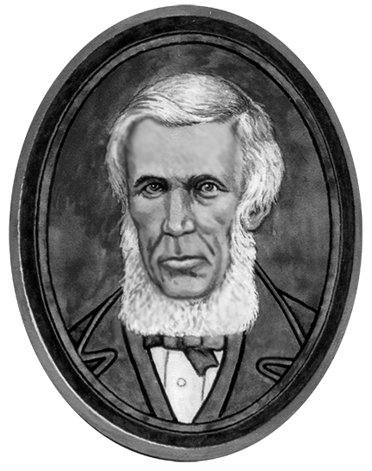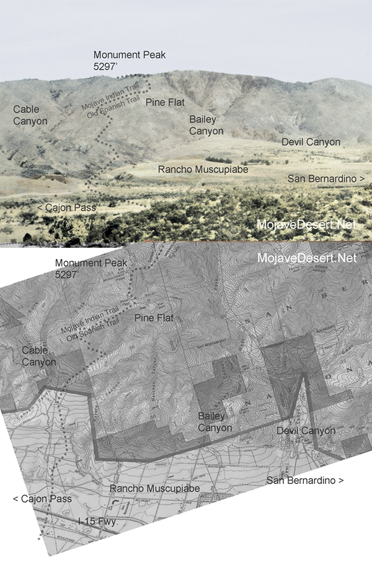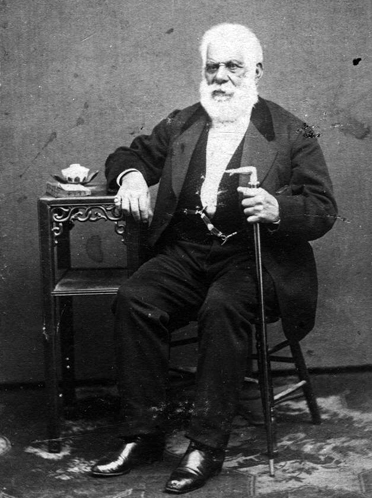Michael White/Miguel Blanco
Michael White (Miguel Blanco) – Old Spanish Trail[1]By Angela Reiniche
“I shall never forgive myself for having taken the word of those villains, for villains they were, of the blackest kind.” Other than this statement, and a few similar sentiments, Michael White spoke little of his experiences on the Old Spanish Trail when he was interviewed in California by Thomas Savage in 1877. The most memorable event of his 1839 journey from Los Angeles to New Mexico took place when he witnessed his companions attack what he described as a “Paiute rancheria.” After seeing a “little Indian boy, about [twelve] years old, with his arm nearly shot off,” White called his fellow travelers “a pack of damned brutes and cowards.” After they convinced him to aid in disarming an elder of the band, on their promise that no harm would come to him, the “villains” went back on their word and “riddled him with bullets.” [2]
When the violence against the Paiute did not stop, White raised his gun in their defense. Although he pulled the trigger, the weapon failed to fire, probably saving his life from a dozen or so guns pointing back at him. After assuring them that he would “never again travel with such a set of brutes,” the leader, Tomás Salazar, answered that “it’s no sin to kill those pagan Indians.”[3] After the party’s arrival in Taos, White exchanged his horses and mules for blankets and then spent the rest of his time in William Workman’s store. Having developed congenial relationships with William Workman, John Rowland, and Benjamin D. Wilson, all of whom were engaged in business partnerships as fur traders and trappers in Taos throughout the 1820s, he chose to join them when they left with a large party headed toward Los Angeles in the late months of 1841. In speaking of that journey, White only recounted that “we met with no adventures…. I came home to my family at the Mesa just below Los Angeles.” [4] Although Michael White made just a single round trip on the Old Spanish Trail, he developed strong ties with Rowland, Workman, and Wilson. Together, despite White’s reluctance to take sides, they played significant roles in the uprisings that led to American rule in California.
Unlike his companions from Taos, White had extensive knowledge of the economic, social, and political landscape of California. Barely a teenager when he left his home in Kent, England as an apprentice on a whaling vessel, White arrived in Baja California in 1817, during Spanish rule. After an injury incurred while exploring Mexico’s coastline on horseback, he once again set sail in 1819, ultimately becoming captain of his own vessel and earning money smuggling.[5] One schooner captain hired him for thirty dollars per month and for the “privilege of taking two mules’ loads of tobacco or any other goods that might be smuggled.” White smuggled silver out of California for Spanish priests who had been expelled by the Mexican government. The customs officer was “paid for closing his eyes” and from the banished priests he collected a commission of nearly fifty percent.[6] Michael White spent a decade as a sailor of fortune, traveling along and between the coasts of Baja California and the Sandwich Islands. He never made the return trip to England.
White arrived in Santa Barbara in 1828, less than a decade after Mexico won its independence from Spain, and worked for a brief period as a ship builder before making his way to Mission San Gabriel, which by then had just three English-speaking people, a few houses around the plaza, a church, some gardens, and irrigable land. In 1831, he helped build the mission’s schooner, the Guadalupe. That same year, on 22 November, White married María Rosario Guillén, the daughter of Eulalia Pérez de Guillén, Mission San Gabriel’s well-respected llavera, or the “keeper of the keys,” a position that came with relative power within the operational structure of the mission.[7] As necessitated by their Catholic marriage rites, White was christened Miguel María Blanco. The marriage also afforded him Mexican citizenship and, thus, the right to own land. White, whose father and grandfather had been farmers in England, was not yet ready for that life. Within a few days of his marriage, he took charge of the Guadalupe and captained it to Mazatlán and San Blas with a cargo of “dry tongues, olives, wine, dried beef, soap, Mission aguardiente (spirits) and other trifles, and two priests, not of the missionaries here.”[8]
Within a couple of years and after a few trips on the Guadalupe, Michael White opened a small store at Los Nietos, six miles south of the mission, between the present-day cities of Whittier and Pico Rivera. He was appointed alcalde of the rancho, a position which functioned more like a magistrate or justice of the peace than the same appointment in the context of city governance. White did his best to resist pressure to fight in the revolutions and insurrections that overwhelmed southern California during Mexican rule. Although White did not offer any serious reflection on his decisions, perhaps the ongoing pressure to join in the battle for control of California provided impetus for his 1839 journey to Taos. That the San Gabriel and Los Angeles rivers “met and overflowed the whole country” in January 1839 and laid ruin to White’s home and possessions might also have given reasonable motivation for engaging in overland trade between California and New Mexico.[9]
Shortly after his return to California in 1841, he received a concession of five hundred varas north of the former Mission San Gabriel. He named it Rancho San Ysidro, planted a vineyard and orchards, raised cattle and sheep, and settled down with his wife and children in a house still standing on the grounds of the present-day San Marino High School. Two years later, in April 1843, Governor Manuel Micheltorena granted to White the Muscupiabe Rancho, located at the mouth of Cajon Pass, primarily for the purpose of heading off Indigenous stock thieves coming from the Mojave Desert through the pass. Then, in 1845, White’s new friends, particularly William Workman, called on him to join their struggle to replace Governor Micheltorena with Pío Pico. Despite his misgivings about the revolution, he fought in the Battle of Cahuenga and in the Battle of Chino. Pío Pico became the last Mexican governor of California and confirmed White’s Rancho San Ysidro grant on 27 March 1845. He remained the alcalde. It is interesting to note the connection between the Pico and Guillén families – Eulalia Pérez de Guillén was the midwife to the Pico family and had delivered both Pío and his brother.[10]
California’s mid-century transition from Mexican to United States rule presented significant challenges for Mexican citizens. White had tried his luck during California’s gold rush but had returned home to Rancho San Ysidro with little and continued to farm and ranch on the land, struggling to support his family amid the rapid transformation of the state’s economic, social, and political landscape. Not unlike many Mexican landholders, by the time that the new government confirmed Michael White’s land grant in 1872, he had sold most of it to pay off considerable legal debts. One ten-acre parcel, sold in 1870 to his daughter Francisca and her husband, José Heslop, remained in the family until it was sold in 1874. White then moved to Los Angeles to live with his children until his death in 1885. Significantly, Workman, Wilson, and Rowland, the men with whom he fought to oust Micheltorena, the same men he had met in Taos in 1839 and had returned on the Old Spanish Trail to southern California with, in 1841, prospered under American rule.[11]
[1] Part of a 2016–2018 collaborative project of the National Trails- National Park Service and the University of New Mexico’s Department of History, “Student Experience in National Trails Historic Research: Vignettes Project” [Colorado Plateau Cooperative Ecosystem Studies Unit (CPCESU), Task Agreement P16AC00957]. This project was formulated to provide trail partners and the general public with useful biographies of less-studied trail figures—particularly African Americans, Hispanics, American Indians, women, and children. Thank you to the Old Spanish Trail Association for providing review of draft essays.
[2] Michael White and Thomas Savage, California All the Way Back to 1828 (Berkeley, Calif.: Bancroft Library, 1877), 44.
[3] Ibid., 46.
[4] Ibid, 47.
[5] William W. Ellinger III, “Michael White Adobe,” National Register of Historic Places Nomination Form, Pasadena, Calif.: Friends of the Michael White Adobe, 2014, p. 16.
[6] White, California All the Way Back, 22.
[7] Marriage records from Mission San Gabriel cited in White, California All the Way Back, 15. For more on Eulalia Pérez, see Bárbara O. Reyes, Private Women, Public Lives: Gender and the Missions of the Californias (Austin: University of Texas Press, 2009).
[8] Ellinger, “Michael White Adobe,” 16; White, California All the Way Back, 32 (quote).
[9] Ellinger, “Michael White Adobe,” 16; White, California All the Way Back, 28 (quote).
[10] Ellinger, “Michael White Adobe,” 16–17; White, California All the Way Back, 48.
[11] Ellinger, “Michael White Adobe,” 17; White, California All the Way Back, 93, 39.

Michael White/Miguel Blanco

Rancho Muscupiabe

Pio Pico